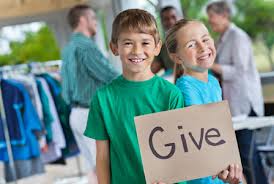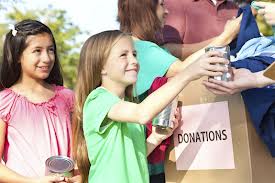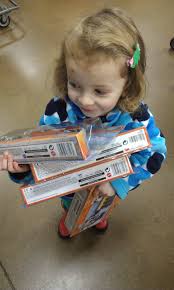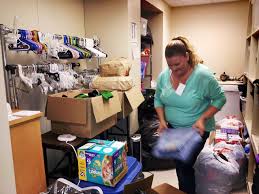One great fundraising event to do through a school is a race night. As Fundeo explains, “Hold a race night event. A Fundeo race night is very easy to organise and great fun it makes a great social event too. It can be run as a family event, or as an ‘adults’ only night – you just choose a film category (‘U’, ’12’ or ’15’ age group), personalise it as much as you wish and order online in our shop. It couldn’t be easier. Ideal for club, school, PTA, corporate, church or charity fundraising. It is easy to find a venue too whether its a village hall, a local club or pub. Your local pub will be delighted to host the event too because a pub race night promises thriving bar sales at the event.”
Adventures in Learning About Charity
Children Learn from their Role Models
Children spend most of their days surrounded by classroom furniture, but that does not mean that parents can’t be a huge influence on their children. It is well known that children learn more from the people they look up to and respect than they do from books or lectures.
Simply put, children learn by example. No need for amazing stories of good deeds which were richly rewarded. What will convince your children of the importance of giving is the example you as a parent sets in the realm of charity. Go serve meals at a soup kitchen. Give money to the beggar in the town square. Write a check to a good cause. You can be sure your child will learn much more from these simple acts than from the most amazing stories, lectures or persuasive arguments about the importance of giving.
Talk to your children about why you give and to whom you give. By sharing your values you are sharing yourself, which your children will respect. Some parents are worried about exposing their children to the harsher realities of life- the painful experiences that might be better to shelter children from- it seems that the joy of helping outweighs any negative side effects which might arise from the sad or tragic story surrounding the person or people who are being helped.
One educator who teaches about teaching children about charity notes,
“Kids can handle so much more than we give them credit for.”
Another educator explains that teaching about charity not only brings us closer to the causes that we hold dear, but it also brings us closer to the people we most hold dear: our children.
“We call it trickle-up charity. The effort starts with the kids, but the parents often get the biggest payoff of all.”
Teaching Charity All Around the World
Kids enjoy clean and safe drinking water from a well in Bulgeta, Ethiopia. pic.twitter.com/NtnEoVMRpj
— charity: water (@charitywater) January 21, 2014
It is Always the Right Time to Teach About Charity
Whoever thinks that children learn best sitting at their school desks did not see a parent
who can make every moment a learning opportunity. For instance, if you want to teach your children about the importance of giving charity, all you have to do is take your child into any large city center, shopping mall or other public place where people gather. Chances of seeing a homeless person are unfortunately high.
Explain to your child or children how it came to be that someone is without a home, and be sure to give this person some money to help ease his way.
Another place to learn about giving is by visiting an elderly person, either in an old age home, or at a community center which organizes activities for senior citizens. Become friends with an older person; find out about his/her life. You may find that you and your children have made some new friends.
Find a chance to discuss with your children how important it is to reach out to people who are in need.
“The idea isn’t just to sensitize your child to some of the pain and suffering in the world, but to give her the great gift of thinking that she has the power to help make it better.”
Teacher’s Treasures and Charity
Teaching Charity 101
Not all learning, not even the most important learning, is done sitting in school chairs. It is up to parents to teach their children the importance of helping others, either by physically helping others to do things they might not be able to do on their own, or by giving money for basic things that all people have a right to.
One woman named Peggy Houser is a financial planner who wrote a book called “Teach Children About Money” in which she suggests that giving children an allowance is a great way to educate them about giving money to charity.
Houser advocates starting an allowance system when children begin school. Then parents teach their children to divide up the money into three parts: money for savings, money for spending, and money for helping others. Make it clear that this is an important family value by saying that,
“Our family believes it’s important to share our good luck with people who are less fortunate.”
Don’t become fixated on what percentage of the total should go to charity; just emphasize that giving should be a part of the normal routine of money management.
“The goal is to make giving money to those in need a routine,” says Houser.
Enjoy this School’s Charity Basketball Game
The Little Ones that Want to Give
Children might not understand the abstract idea of giving money as a way of helping others. To really make an impact on young children, they need to see actions that directly improve the lives of those in need.
“It’s hard for kids to grasp that the money is going to, say, buy bread, which in turn will help feed ten homeless people,” says Deborah Spaide, founder of Kids Care Clubs. “Many children can’t take the process that many steps forward in their minds.”
Kids Care Clubs are a great way to introduce children to the importance of giving. Surrounded by school furniture all day, children may forget the importance of helping.
“Children naturally look for ways to make a contribution and help others,” says Spaide. But just as we give our children opportunities to use their legs when they’re learning to walk, we need to give them opportunities to exercise their charitable muscles so they become really good at giving too.”
Spaide helps parents give their kids the experience of charitable behaviors firsthand. Even young children only in pre-school will be affected by helping their parents bag lunches for soup kitchens, distribute clothes to people in homeless shelters, or help an elderly person to take care of his living quarters or garden.
As your children grow their ability to help also matures. But as parents we are constantly challenged to meet our children’s changing needs. Constantly educating them about new ways to help is a gift to your children that will last a lifetime.
Five Great Ideas to Teach Your Kids to Give
5 Ways to Teach Kids Charity: http://t.co/Sr20Qig8PN by @MarianneWait w/ tips from KnowMore Expert @DrRobyn #volunteering
— KnowMore (@KnowMoreTV) October 25, 2013
Teaching Our Children About Giving
Almost everyone agrees it is a positive value to give to those less fortunate them ourselves.
It therefore follows that any value that we hold dear is one that we wish to impart to the next generation. Parents, and society as a whole, believe there is more to life for students than being surrounded all day by classroom furniture. Here is how one person involved in teaching children about giving puts it:
“As a parent, you have an obligation to use special occasions to instill the importance of giving in your children, and then support them in those projects,” explained Art Taylor, CEO of the Better Business Bureau’s Wise Giving Alliance.
Special occasions such as holidays and birthdays are an excellent time to put an extra emphasis on giving, but the rest of the year should be punctuated by continuous charitable behavior. And giving is not only good for those on the receiving end. It is quite the opposite. Much of the benefits of giving are experienced by the giver, such as a rise in self-esteem, the development of social skills and an introduction to the greater world which can help them appreciate their own lives more.





